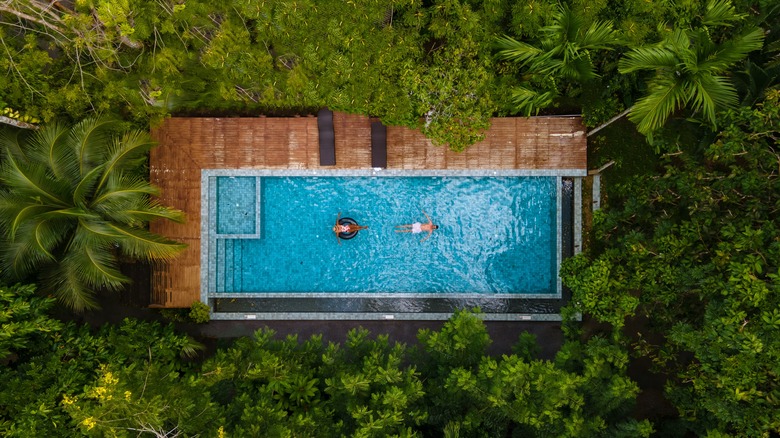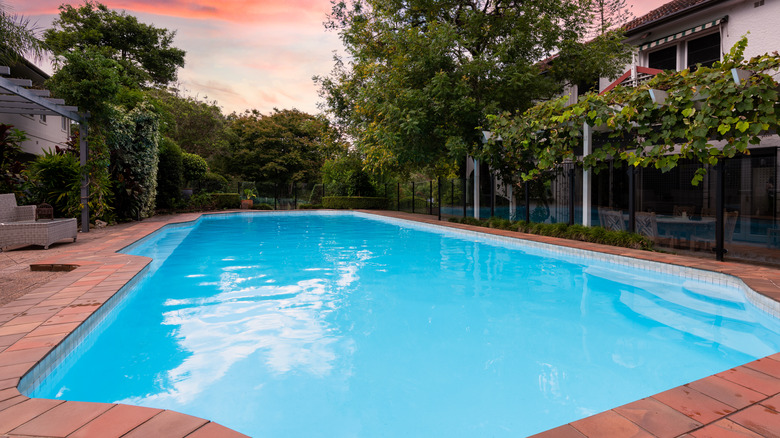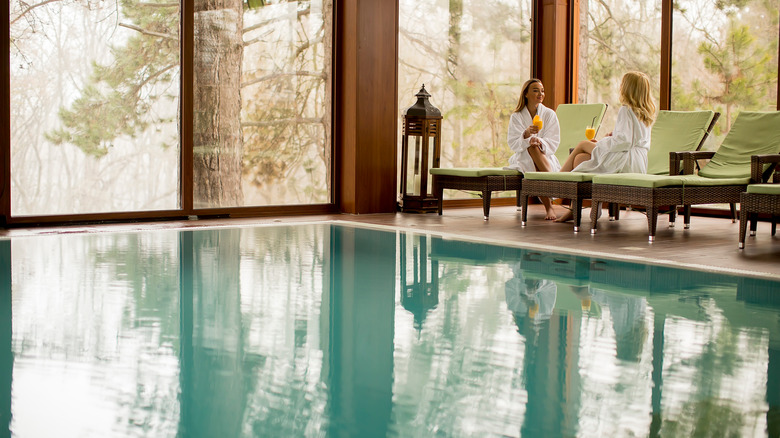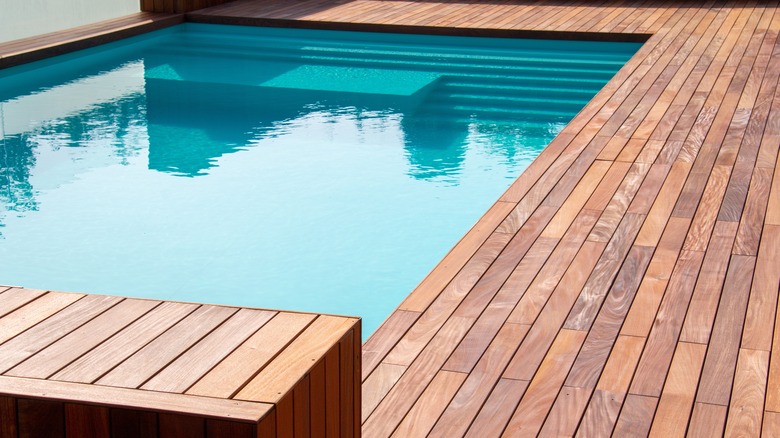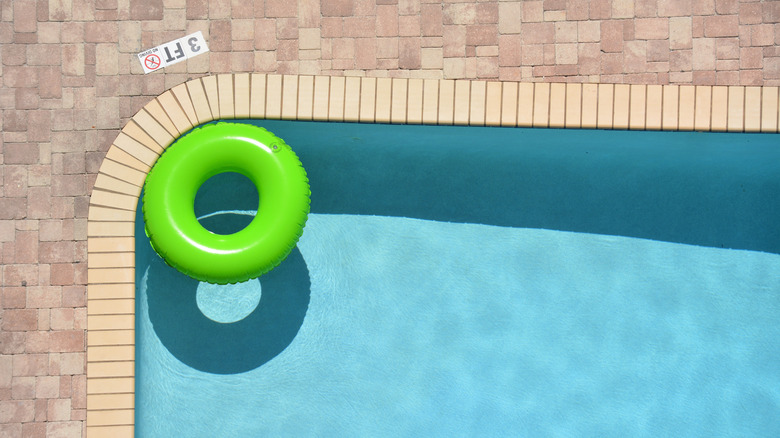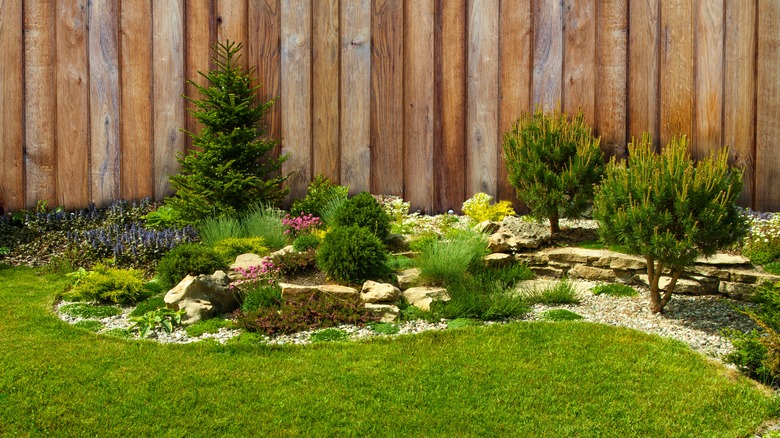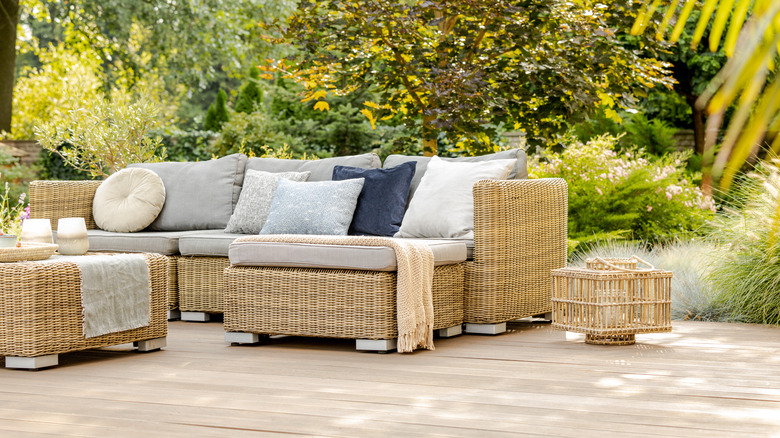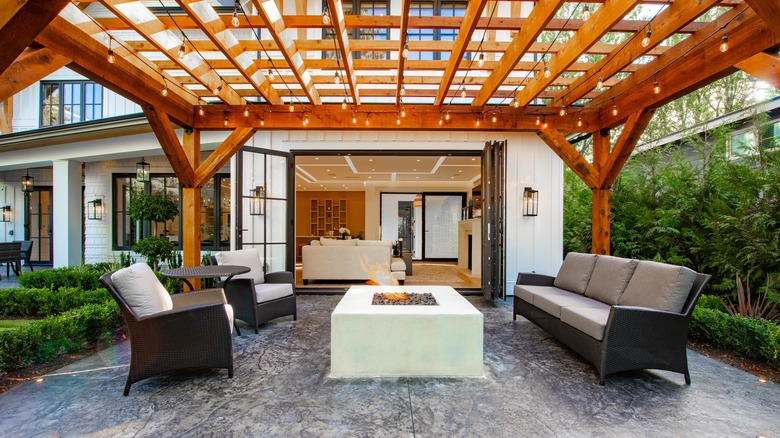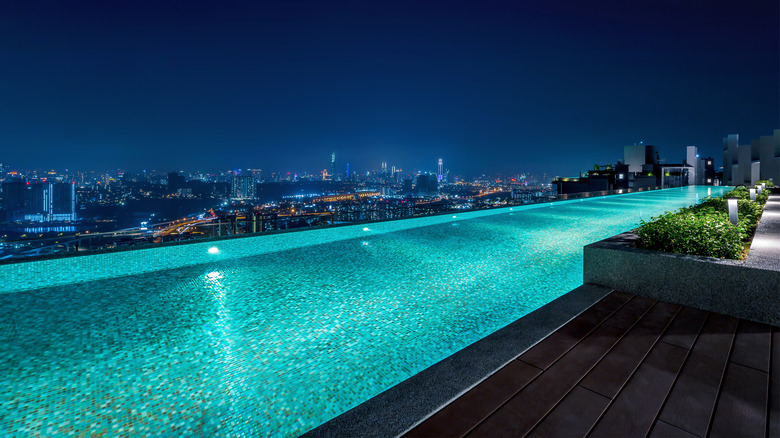Designing The Perfect Pool For Your Backyard
Designing the perfect pool is all about planning around your vision regarding your long term use of the amenity. In order to create the perfect pool for your home, the first thing you'll need to do is think about how you'll use the space. Pools come in many different varieties, and the spaces that surround them are equally unique. This means that, when designing any new pool area for your home, you should look inward to determine the kind of pool and decking area that will best serve you and your family (via Leisure Pools).
Planning your pool build can certainly be done without professional help, but speaking with a contractor is often a great way to gain crucial insight into the building process. It's also worthwhile to hunt around for design ideas in order to fully flesh out your perfect backyard amenity. You can do this by searching through home listings in your area or beyond, by speaking with friends who already have pools at their home, or through candid conversation with pool contractors. It's crucial to develop a fully-formed idea before you break ground on any pool installation project. This is because every aspect of your new pool design will be integrated with one another, and changes later down the road can result in severe delays or the need to tear out newly installed components and rebuild them.
Pool placement: above, below, or both
Off the bat, decide whether you want your pool to be inground, above ground, or part of a layout that combines the two. Inground pools are perhaps the most iconic layout for backyard water amenities. These are pools that are dug into the ground and make use of cement and other materials to build a permanent installation. Inground pools require integrated plumbing and a coherent means of tying the deck space and dimensions of the pool together. They require more lead time and planning than above ground installations, but there is a reason why they are the favorite among homeowners. These pools require less substantial maintenance than the more temporary type of construction of an above ground unit. Similarly, inground pools can add increased value to your home compared to an above ground addition.
Above ground pools have their purpose as well though. First, above ground pools are cheaper than inground (via Pool Pricer), and they can also be moved, which is convenient if you're not sure your yard situation will stay the same longterm. It's also important to note that above ground pools have come a long way in relation to design features. Historically, these pools often came in simple, round designs, and customization was limited to diameter and the occasional material choice. Today, above ground pools can take on a number of different shapes, however, inground pools still remain the most customizable.
Lastly, one option that inground pool builders have at their disposal is the use of terracing. Terracing a pool is the process of raising a part of the installation above the deck surface, thereby creating a mixture of inground and above ground. These types of pools may be seen in hotels, luxury homes, and other high-end facilities. They can be used to great effect to create a unique audience in your backyard space.
You may even consider adding an indoor pool to your home's footprint
One other option that homeowners have at their disposal is the construction of an indoor pool. To add an indoor pool on your property will require a lot of space, and people considering the use of an indoor pool will need to add the framework to facilitate this build. An indoor pool can give you access to year-round swimming, and is often seen as the height of luxury when it comes to pool amenities, according to Realtor. Indoor pools are often used by elite athletes to train throughout the year, and they can be a great addition to homes in regions that see extended cold periods.
There is more to putting in an indoor pool than just the pool itself — it requires ventilation elements, storage facilities, safety equipment, and perhaps even a heating element. As a result, making the decision to install an indoor pool comes with many additional strings attached that homeowners may not be aware of. These types of pools can add incredible value to your property, but they come with a much greater level of responsibility and a more hands-on maintenance routine than units that are placed outside.
The pool deck acts as the primary space for all pool area activities
After you've decided on the kind of pool you want, along with the shape and size, the next step is to design and create your pool deck. Pool decks can be built from a number of different materials. Many homeowners choose to incorporate a paver design for their pool decks, as pavers are a great option because they are durable concrete bricks that will last a very long time (via E.P. Jansen Nursery). What's more, pavers look much better than a solid concrete slab. This gives you all the benefits of a hearty and long lasting decking solution, without the uncouth look and feel of simple concrete. Of course, a concrete slab that makes use of segmenting techniques and surface textures can be immensely stylistic, so it's still worth checking out all your options.
Another option is to extend a wooden decking installation out to the new pool. Wooden decks are often aesthetically pleasing, and they're relatively inexpensive in comparison to some other options for expanded deck construction. A wooden deck will require more routine maintenance than pavers or solid concrete, but the level of customization with stain options and exterior decking paint makes this a good choice as well. Of course, if you're thinking of a wooden deck for around the pool, you'll need to double down on the use of sealing products to protect the wooden material from rot and the potential for negative interactions with the pool chemicals.
Beyond the material used to construct your deck, you'll also need to think about the size and shape, too. When building out a pool deck, you'll be looking to incorporate some key pieces of pool furniture and other exterior amenities. Part of the allure of a backyard pool is the ability to use this space for a variety of different activities and functions. On some days, you may stay primarily in the pool, while others you may host a family gathering around it — this means that you'll need to think about spatial considerations to support many activities.
Think about your coping preferences
The coping is the edge material that connects the pool to the surrounding surface, and provides a finished look to the deck space and the whole pool experience (via Poolonomics). With above ground pools, coping options may be limited or completely irrelevant. However, with an inground pool, this feature is a crucial component.
A paver deck might make use of specialized paver segments that curl over the edge and seamlessly transition from deck to pool. Wooden decking might make use of trim pieces that frame the deck against the drop into the water. It can be easy to overlook the value of coping pieces, but make no mistake about it, as it plays an integral role in the way that your pool fits — both visually and physically — within your backyard.
Coping is another area in which you should rely on expertise from your pool construction expert. Because this element is often forgotten by homeowners during the designing process, letting your contractor take the lead in this area will help you end up with a design choice that's right for you. In the same way that molding around the floor and ceiling in a room can add a personal touch to the space, the coping you select for your pool deck offers some uniqueness.
Landscaping is a must for achieving your desired ambiance
Once you've selected an overall layout for the pool and surrounding area, you'll need to work on building out the landscaping elements that exist beyond the confines of the pool itself. Landscaping is a core component of good homeownership. From lawn maintenance to the cultivation of trees, shrubs, and flowering plants around the house, your landscape plays a direct role in the vibe that the exterior of your home exhibits. There is no right or wrong way to go about the landscaping process around your pool, but experts can help you design the perfect backdrop for this space of relaxation and play. Many homeowners will play with layers and depth changes to create a more intricate and exciting backyard. Matching height and depth differences allows for a wonderfully layered vista for you and your guests to admire (via Garden Design). Another option is to use a more minimalist approach and plant only a few, key hedges or trees in this space, and maintain a mostly empty, grassy landscape.
The way you and your family utilize the area around your home can help dictate what kind of landscaping works best for you. Installing a pool typically means cutting down on this size of the lawn in your backyard. However, this doesn't mean that you will eliminate the entire space. Homeowners with young children may want to preserve an open area for outdoor play, whereas older adults looking to add a pool for relaxation may prefer bushes and trees that add to the beauty of the landscape, while also providing privacy. Thinking about the way you want your yard to look and feel, as well as how you'll use it, will help dictate what kind of landscaping installations you opt to incorporate.
Patio furniture ties together a cohesive decking space
Another important consideration to make when building a new pool is the use of outdoor furniture. Homeowners who already have a backyard deck may already possess a significant volume of patio furniture. However, these pieces may be old or in need of replacement in order to create the pool atmosphere you desire. Once again, considering the way you intend to use this backyard space can help dictate what types of pool deck furniture will serve your needs the best (via River Pools).
You may want to incorporate lounge chairs and umbrellas if you intend to spend a lot of time sunning yourself. Alternatively, for families who want to make extensive use of grilling equipment, a picnic table or any other type of outdoor seating area is a must. Regardless of your primary usage plans for the pool and space around it, some type of seating will be required in just about all cases. Finding the right blend of patio furniture to tie together the energy of this new space is crucial to putting the finishing touches on your new pool area.
Consider heating (and cooling) needs in the pool and around it
Homeowners in the midst of putting in a new pool may want to incorporate heating elements to make the pool more comfortable across changing seasons. Pool heaters come in many different forms, and common make use of propane, electric, or solar-powered heat generation. As Forbes Home notes, gas powered heaters are best for quick heating, whereas electrical may provide less heat, but is better for maintaining a temperature over an extended period of time. Each of these provide their own unique blend of benefits, but for a family concerned about their environmental impact, the use of solar heating is simply a no brainer. Just be aware that solar panels involves a higher upfront cost, and you must also live in an area that receives enough sunlight. One thing of note when it comes to pool temperature maintenance is that an expensive installation isn't necessarily required to develop a general consistency in temperature. With a few ingenious tricks to insulate the pool against the winter chill, you can incorporate heating elements without the hire cost associated with a traditional heat source.
Another key consideration to the comfort level of your pool and deck space is the installation of cooling features. While during the winter, pool heating or a standing heater for the deck may be a priority, during the summer, fans may be required to provide the right kind of temperature control. Thinking about these additional amenities as you go about the building process can help you fine tune your efforts to create the perfect environment for you and your family.
Pool houses, pergolas, and other fixtures can elevate a new pool immensely
Included in any consideration of the construction of a new pool should be amenities that are built around the space. Building a pool house is a great way to incorporate covered elements that can help you run a television out to the deck space, or include showering facilities and storage space dedicated to the pool. A pool house is a great option, but it isn't the only one when it comes to extra amenities.
A pergola is another solid choice for homeowners looking to add high quality features to this exterior relaxation space. A pergola is a simple covered area that makes use of stylized timber framing and can be constructed as a backyard DIY project for maximum cost-effectiveness (via wikiHow). This will not only give you shade from the sun, but even a simple pergola can transform the atmosphere of the pool deck. These types of amenities are often seen at luxury hotels. Featuring these small luxuries in your home can elevate the style and comfort level on your property. It's worth looking into these added bonuses that can raise the value of your home and give you an overall more elevated experience.
Don't forget about safety inclusions and lighting
Lastly, it's important to remember that any new pool will require certain safety measures. Many building codes command homeowners and contractors alike to include things like fencing or chime alarms on doors that lead to the backyard. These safety standards are in place to protect young children, pets, older adults, and anyone else who may fall victim to drowning or any other type of injury that pool features can inflict on unsuspecting victims.
Of course, your pool will be built as a feature to enhance the enjoyment of your property, and considering it as a hazard might not seem obvious. Yet, 8,080 nonfatal drownings and 3,960 unintentional, fatal drownings occur on a yearly basis in the U.S., according to the CDC. Severe injury and death can result from irresponsible pool ownership practices, and these consequences can happen within just a few seconds of unsupervised use. Therefore, it's simply common sense to include safety features in your building plan. Fortunately, any pool contractor that you hire to perform this installation will have an intimate knowledge of the kinds of safety features that must, and should, be included.
Another consideration that you should make surrounding safety and general usability is in lighting (via Landscape Lighting Pro of Utah). A pool that doesn't make use of ample lighting simply can't function as a gathering space in the dark. Taking the time to think about lighting in the pool and above it to illuminate the deck might be one of the last things you consider, but it should never be forgotten about.
